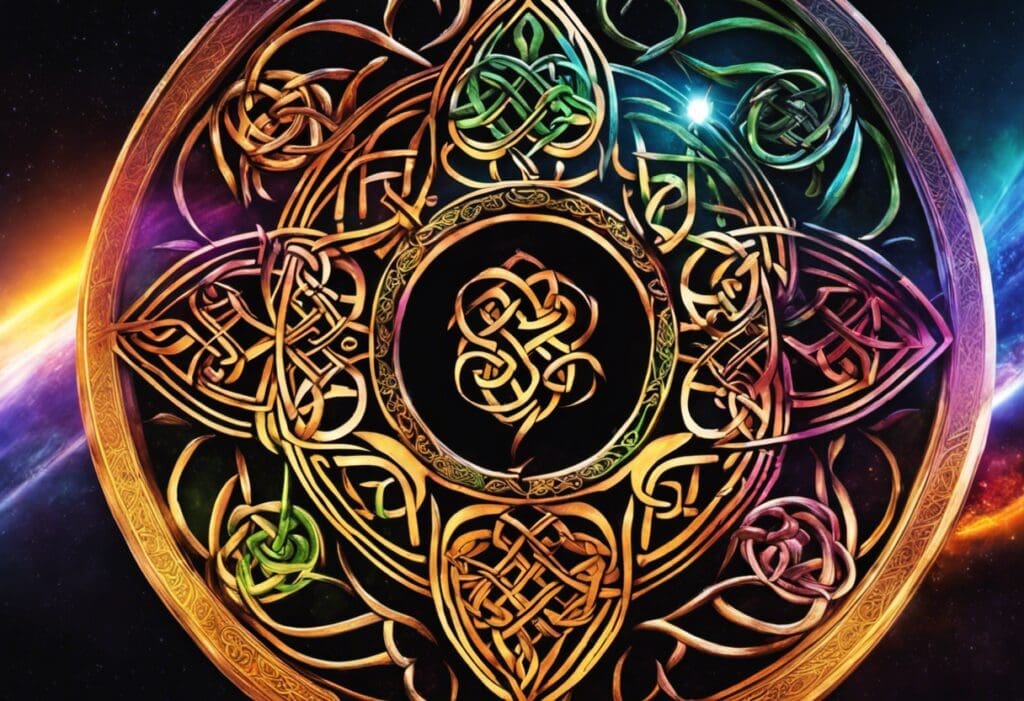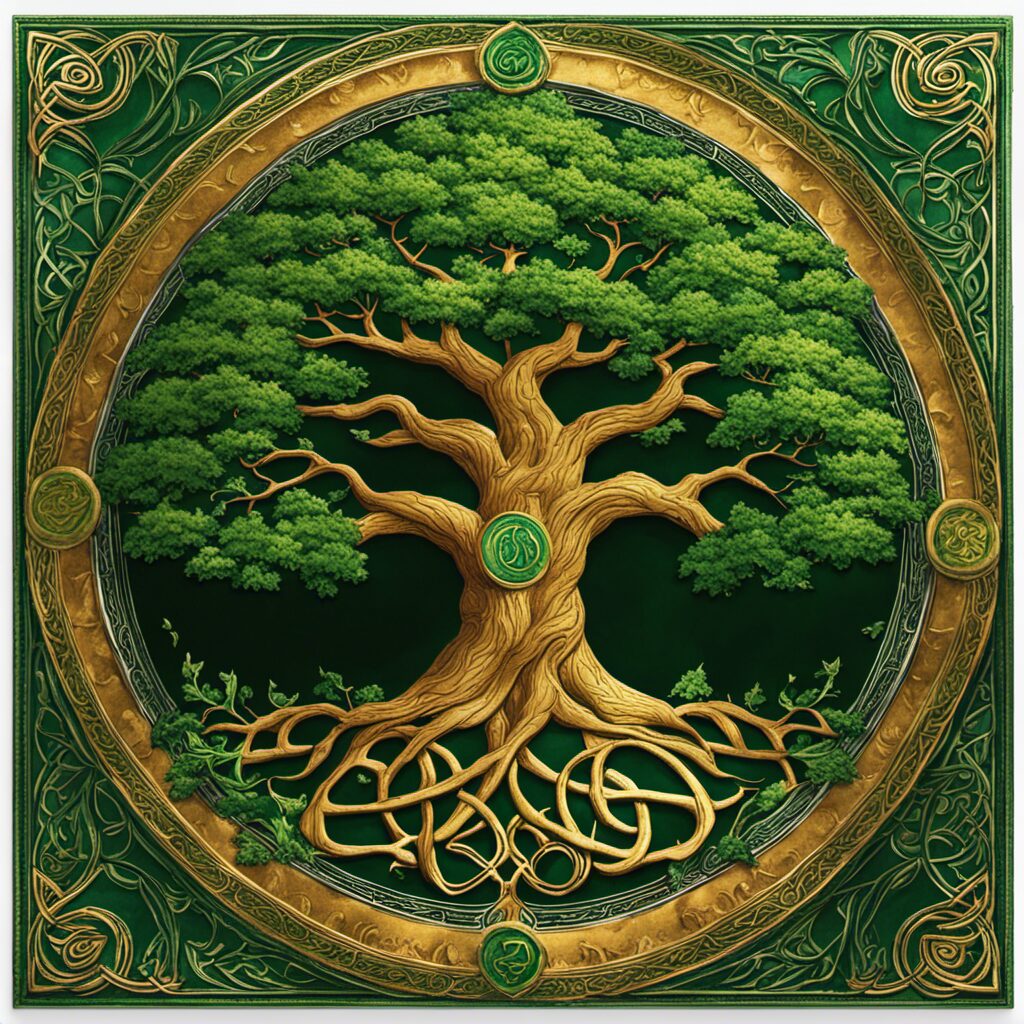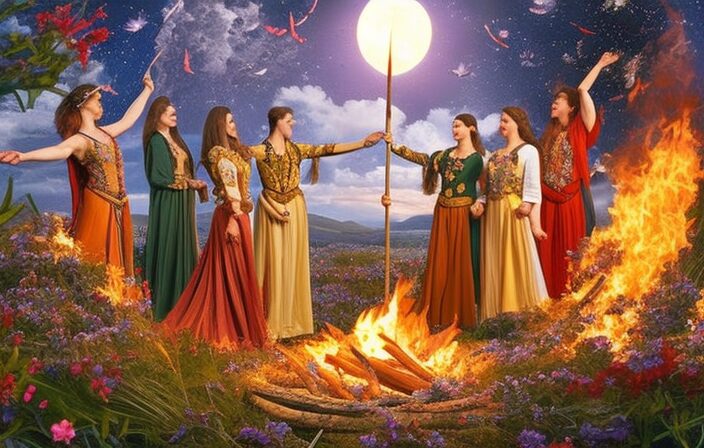The ancient Celtic calendar is a subject of intrigue and mystery, holding within it a wealth of lesser-known trivia. Its origins are rooted in the ancient Celtic civilization and its unique features distinguish it from other calendars.
Moon phases played a crucial role in the Celtic calendar, shaping their festivals and religious practices. Delving into these lesser-known festivals reveals deep cultural significance and rituals associated with them.
Moreover, the Celtic calendar also influenced daily life, impacting areas such as agriculture, hunting, and social customs.
This article uncovers fascinating facts about the captivating world of the Celtic calendar.
Key Takeaways
- The Celtic calendar originated from ancient Celtic culture and was based on celestial events, agricultural practices, and religious beliefs.
- It is a lunisolar system that combines lunar phases and solar cycles, with each month associated with specific deities or natural elements.
- The calendar placed emphasis on seasonal festivals and rituals, marking important transitions throughout the year and fostering social cohesion.
- The Celtic calendar has had a significant influence on modern calendars and festivals, with holidays like Halloween, May Day, and Yule incorporating elements from Celtic celebrations.
The Origins of the Celtic Calendar
The origins of the Celtic calendar can be traced back to ancient Celtic culture and their observation of celestial events. The Celts were a group of Indo-European people who inhabited various regions in Europe from the Iron Age through the Roman period. They had a deep connection with nature and believed that celestial phenomena such as the movements of the sun, moon, and stars held great significance.
The development of the Celtic calendar was closely tied to agricultural practices and religious beliefs. It consisted of a lunisolar system, meaning it followed both lunar phases and solar cycles. This allowed them to track both time and seasons accurately. The calendar was divided into months based on lunar cycles, typically consisting of 29 or 30 days.
Cultural significance played a significant role in the Celtic calendar as well. Each month was associated with specific deities or natural elements, reflecting their beliefs and rituals related to agriculture, hunting, and fertility. Festivals were celebrated at important points in the calendar year, marking transitions between seasons and honoring gods or goddesses.
Overall, the origins and development of the Celtic calendar highlight the close relationship between ancient Celtic culture, nature observation, agriculture, religious beliefs, and celestial events. It served as an essential tool for tracking time while also holding cultural significance through its association with deities and seasonal festivals.
Unique Features of the Celtic Calendar
Lunar-based timekeeping, seasonal festivals and rituals, and the influence on modern calendars are key features of the Celtic calendar.
The Celtic calendar was primarily based on the cycles of the moon, with each month corresponding to a lunar phase. This lunar-based system not only determined the timing of important events and activities but also played a significant role in shaping Celtic culture and religious practices.
Furthermore, the Celtic calendar’s emphasis on seasonal festivals and rituals reflected their deep connection to nature and marked important agricultural milestones throughout the year. These traditions have greatly influenced modern calendars, as many cultural celebrations and holidays still follow a similar pattern based on lunar or solar cycles.
Lunar-Based Timekeeping
Based on astronomical observations, the Celtic calendar relied on the lunar cycle for tracking time. The moon phases played a crucial role in this lunar-based timekeeping system.
The Celtic people closely observed the changes in the moon’s appearance throughout its 29.5-day cycle and used it to divide their months. Each month began with the new moon, known as ‘Samonios’ in Gaulish. As the moon waxed and waned, different phases marked significant points within the month, such as first quarter, full moon, and last quarter.
These lunar cycles not only helped determine the start of each month but also played a role in agricultural practices and religious rituals for various Celtic communities across Europe. This reliance on celestial movements highlights the close connection between ancient societies and their environment.
Seasonal Festivals and Rituals
Seasonal festivals and rituals were an integral part of the Celtic culture, reflecting their deep connection with nature and the changing seasons. The ancient Celts celebrated four main seasonal festivals, which marked important transitions throughout the year. These festivals were based on the Celtic calendar symbols, representing key elements of their spiritual beliefs and agricultural practices.
Imbolc, held in early February, honored the beginning of spring and was associated with purification and fertility. Beltane, celebrated on May 1st, welcomed summer and focused on fire rituals for protection and abundance. Lughnasadh took place in August to commemorate the first harvest and give thanks for sustenance. Samhain, observed at the end of October or beginning of November, marked the transition into winter and was a time when they believed the veil between worlds was thinnest.
These ancient Celtic traditions not only provided a framework for communal celebrations but also served as a means to honor their interconnectedness with nature and foster social cohesion within their communities.
Influence on Modern Calendars
The influence of ancient Celtic festivals and rituals on modern calendars can be seen in the continuation of certain traditions and the incorporation of similar themes. Cultural adaptations from Celtic celebrations have become integrated into various contemporary festivities, highlighting their historical significance.
Here are three ways in which Celtic calendar customs have influenced modern calendars:
- Halloween: The origins of this popular holiday can be traced back to Samhain, an ancient Gaelic festival that marked the end of summer and honored the dead.
- May Day: Beltane, a traditional Gaelic festival celebrating the arrival of summer, has influenced modern May Day celebrations with its focus on fertility rituals and outdoor festivities.
- Christmas: The celebration of Yule by the ancient Celts during winter solstice has been incorporated into Christian traditions surrounding Christmas, such as lighting candles or decorating trees.
These cultural adaptations demonstrate how ancient Celtic festivals continue to hold historical significance within our modern calendars.
The Role of Moon Phases in the Celtic Calendar
This discussion focuses on the lunar influences on dates, the moon’s impact on festivals, and the significance of lunar cycles in the Celtic calendar.
The Celtic calendar was closely tied to celestial bodies, particularly the moon, which played a crucial role in determining important dates and festivals. Understanding how lunar phases influenced these events provides insights into the cultural and religious practices of the Celts and their deep connection with nature.
Furthermore, recognizing the significance of lunar cycles helps unravel the intricate workings of this ancient calendar system and sheds light on its unique features.
Lunar Influences on Dates
Lunar phases played a significant role in determining dates within the Celtic calendar. Here are three ways in which lunar influences impacted the calendar:
- Influence on agricultural practices: The Celts were an agrarian society, and they relied heavily on the lunar phases to guide their farming activities. They observed how different moon phases affected plant growth, soil fertility, and animal behavior. By aligning their planting, harvesting, and breeding schedules with the lunar cycles, they aimed to optimize agricultural productivity.
- Connection to nature’s rhythms: The Celts had a deep reverence for nature and believed that it held immense power and wisdom. They saw the moon as a celestial body that governed natural rhythms and cycles. By incorporating lunar phases into their calendar, they sought to honor this connection with nature and live in harmony with its ever-changing patterns.
- Spiritual significance: The moon was also seen as a symbol of divinity and spiritual guidance by the Celts. They believed that certain moon phases held specific energies or qualities that could influence human emotions, actions, and outcomes. Therefore, by aligning important events or rituals with specific lunar phases, they hoped to harness these spiritual energies for positive outcomes in their lives.
Overall, the incorporation of lunar influences into the Celtic calendar not only guided practical aspects such as agriculture but also reflected their profound connection to nature’s rhythms and spiritual beliefs.
Moon’s Impact on Festivals
Moon’s impact on festivals can be observed through the scheduling and rituals associated with specific lunar phases.
In many cultures, the moon plays a significant role in determining the timing of festivals and religious ceremonies. Astrological connections and lunar symbolism are often intertwined in these practices.
For example, in ancient Celtic culture, certain festivals were aligned with specific lunar phases to honor deities associated with different aspects of nature. The waxing moon was connected to growth and abundance, while the waning moon represented release and letting go.
This connection between the moon and festival scheduling allowed for a deeper spiritual experience by aligning human activities with natural cycles.
Furthermore, various rituals performed during these lunar-based festivals incorporated symbolic gestures that reflected the qualities attributed to each lunar phase, enhancing their significance within the community.
Significance of Lunar Cycles
Astrological and cultural connections to lunar cycles are evident in the scheduling and rituals of festivals, where specific lunar phases play a significant role in determining the timing of these events. The importance of lunar phases in cultural practices is seen across various civilizations throughout history.
Here are three key reasons why lunar cycles hold such cultural significance:
- Agricultural Significance: Lunar phases dictate planting and harvesting seasons for many agrarian societies. Farmers rely on the moon’s cycle to determine when to plant their crops, ensuring optimal growth and yield.
- Ritualistic Observances: Many religious and spiritual traditions incorporate lunar phases into their rituals and ceremonies. Full moons often mark important festivals or holy days, while new moons may be associated with periods of introspection or purification.
- Cultural Symbolism: The moon’s ever-changing appearance has long been associated with themes such as femininity, cycles of life, and transformation. Lunar phases have inspired countless myths, legends, poems, and artworks that reflect the deep cultural significance attributed to them.
The cultural importance of lunar cycles is a testament to humanity’s fascination with celestial phenomena and our innate connection to the natural world.
Lesser-Known Celtic Calendar Festivals
One of the lesser-known festivals in the Celtic calendar is Beltane, which marks the beginning of summer and is celebrated on May 1st. While many people are familiar with popular Celtic equinox celebrations like Samhain and Imbolc, Beltane often goes unnoticed. This festival has deep roots in Celtic solstice traditions and holds great significance for Celtic communities.
Beltane is a fire festival that celebrates fertility, growth, and the arrival of summer. It is believed to be a time when spiritual forces are particularly active, making it an ideal occasion for purification rituals and protection against negative energies. Bonfires play a central role in Beltane celebrations, symbolizing both renewal and warding off evil spirits.
In addition to its association with fire, Beltane also involves other customs such as dancing around maypoles, adorning homes with flowers and greenery, and performing rituals to ensure good fortune for crops and livestock. These practices demonstrate the close connection between nature and human life in Celtic culture.
While not as widely recognized as other festivals within the Celtic calendar, Beltane offers valuable insights into ancient Celtic beliefs surrounding seasonal transitions and their impact on daily life. Exploring these lesser-known festivals enriches our understanding of the diverse range of customs practiced by Celts throughout history.
Significance of the Celtic Zodiac
The Celtic Zodiac is an ancient system of astrology that originated from the Celtic culture. It is based on a lunar calendar and consists of 13 signs, each corresponding to a specific tree. These signs are believed to have deep connections with nature and offer unique interpretations for individuals born under them.
- Celtic Zodiac Interpretations: The Celtic Zodiac assigns different traits and characteristics to each sign based on the qualities associated with its corresponding tree. For example, those born under the Oak sign are said to possess strength, courage, and wisdom, while individuals born under the Willow sign are believed to be imaginative, intuitive, and adaptable.
- Connection between Celtic Zodiac and Nature: The Celtic people had a strong bond with nature, considering it sacred and viewing trees as spiritual beings. The connection between the zodiac signs and their corresponding trees reflects this belief in the interconnectedness of humans and nature. Each sign embodies certain aspects of the natural world, emphasizing the importance of harmony and balance in one’s life.
- Personal Growth through Nature Symbolism: The interpretation of the Celtic Zodiac offers individuals an opportunity for personal growth by connecting with nature’s symbolism. By understanding their own strengths and weaknesses through their zodiac sign’s attributes, individuals can align themselves more closely with nature’s rhythms and harness its energy for personal development.
How the Celtic Calendar Influenced Daily Life
Influenced by the Celtic calendar, daily life in Celtic culture was structured around the lunar cycles and seasonal changes. The Celtic calendar played a significant role in shaping agricultural practices and establishing a deep connection between the Celts and their natural environment.
The influence of the Celtic calendar on agricultural practices was profound. The Celts relied heavily on farming for sustenance, and they recognized that successful crop growth depended on understanding the natural rhythms of the land. By aligning their planting and harvesting activities with specific lunar phases and seasonal changes, they maximized their chances of a bountiful harvest. For example, certain crops were planted during specific phases of the moon, believed to enhance growth and yield.
Moreover, the Celts viewed nature as sacred and deeply interconnected with their daily lives. They revered trees, rivers, mountains, and animals as spiritual entities. The Celtic calendar reflected this reverence for nature by incorporating festivals and rituals that celebrated various natural phenomena such as solstices, equinoxes, full moons, and changing seasons. These celebrations served to honor the cyclical patterns of nature while fostering a sense of harmony between humans and their environment.
Conclusion
In conclusion, the Celtic calendar is a fascinating and intricate system that played a significant role in the lives of the ancient Celts. Its origins can be traced back to their deep connection with nature and their keen observation of celestial movements. With its unique features and festivals, it provided a framework for organizing time and marking important events.
The influence of moon phases added another layer of significance to this calendar, making it not only practical but also spiritually meaningful. Additionally, the Celtic zodiac further enhanced their understanding of themselves and their place in the world.
Overall, the Celtic calendar offers us a glimpse into the rich cultural heritage of the Celtic people and serves as a testament to their profound relationship with time and nature.
Figure of speech: ‘The Celtic calendar offers us a glimpse into the rich cultural heritage.’




